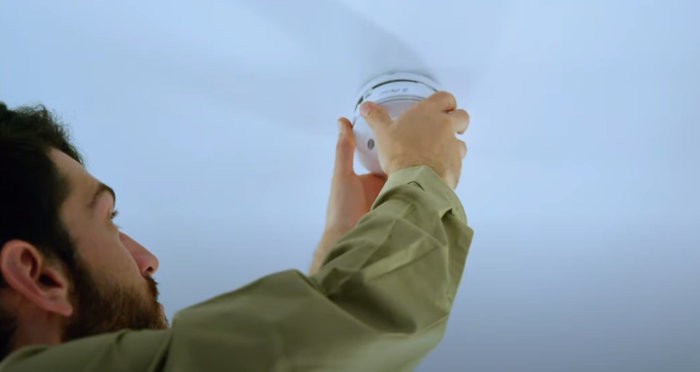Where Should I Install Smoke Detectors?
$198* Smoke Alarm Compliance Check T&Cs Apply, See Below
Choosing the right spot to install a smoke detector in your home can be the difference between evacuating safely and a horrible tragedy. To take the guesswork out of correctly placing the smoke detectors through your home we recommend consulting a professional smoke alarm technician.
The unique design of each home means that what works for one may not be the best spot for another, which is where your professional smoke alarm technician can help. They’ll know the specific smoke alarm legislation for your state as well as the fire safety industry recommendations for your building type.
QLD Smoke Alarm Legislation
In Queensland, the revised Smoke Alarm Legislation has specific requirements for where smoke detectors are placed throughout your home.
Where to Position Smoke Detectors in Your Home
The QLD smoke alarm legislation states that smoke alarms need to be installed:
- On each storey of your home
- Inside each bedroom
- In hallways which connect the bedrooms and the rest of the house
- If your home does not have a hallway between the bedrooms and house the alarm must be positioned between the bedrooms and other parts of the storey/house
- If a storey does not have bedrooms at least one detector needs to be located in the most likely path of travel to exit the building.
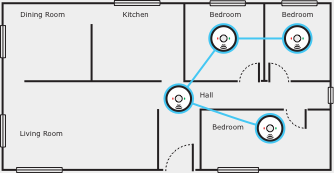
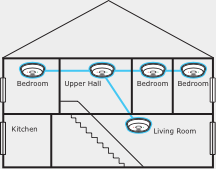
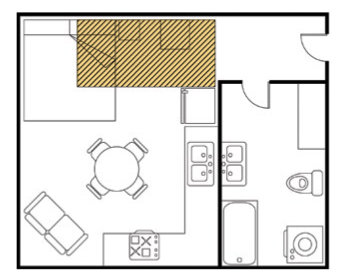
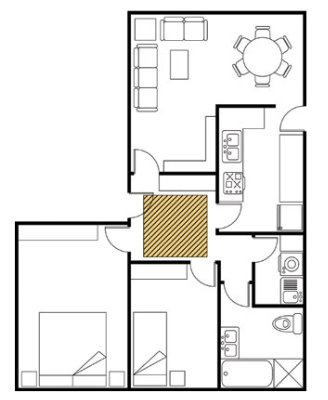
Why Do I Need to Install a Smoke Alarm In a Bedroom?
Smoke alarms make a lot of noise, often you can hear them several houses away, so why do we need to install one in the bedrooms?
Installing smoke alarms in bedrooms means that every person in your home receives the earliest possible warning of a fire, even if they’re in deep sleep, playing loud music, or have the door closed.
It’s been proven that when you go to sleep so does your nose, so relying on your sense of smell to alert you to a fire while you’re sleeping is a big mistake.
Interconnecting the alarms throughout your home so that when the alarm in the kitchen is activated (unattended cooking is one of the leading causes of fire in the home) every smoke alarm in the house will trigger the siren.
Need a Smoke Alarm specialist?

Call us on 1300 054 488
We Can Be There Today!

Send us an Enquiry Online
We’ll get back to you asap!
Installing Smoke Alarms in the Kitchen:
As mentioned above around half of house fires start in the kitchen so it would make sense to install a smoke alarm or two in that room. However, in most cases, smoke alarms in the kitchen are too effective. Repeated false alarms from cooking fumes or steam can lead to residents removing batteries, covering alarms, or taking them down altogether.
To prevent false alarms it’s recommended that smoke alarms are installed near but outside the kitchen, often in the hallway.
If you would like to have a fire warning system in your kitchen installing a heat alarm is a good idea.
Installing Smoke Alarms on Sloped Ceilings:
The Building Fire Safety Regulation 2008 (QLD) states that ‘if the smoke alarm is installed on a ceiling that slopes – must be in an area of the ceiling that is between 500mm and 1,500mm from the apex of the ceiling’. Plus it must not be within 300mm of a light fitting or within 300mm of a corner of the ceiling and a wall.
If the alarm is installed in a stairwell it must not be located where smoke rising in the stairwell will not reach the alarm due to an obstruction.
The alarm must also be installed more than 400mm away from an air conditioner, forced air ventilation (exhaust fan), or the blades of a ceiling fan. All of which can prevent smoke from reaching the smoke alarm.
Where to Install a Smoke Alarm:
- In a bathroom or laundry – to reduce false alarms from the steam which is common in bathrooms and the laundry, it is recommended that smoke alarms are located away from these areas in a hallway or common area.
- In a garage – fire warning systems are needed in every part of the home, garage included. Either a photoelectric smoke alarm or a heat alarm can be installed in the garage.
- If you have ceiling fans – smoke alarms need to be installed at least 400mm from the blades of a ceiling fan to ensure the fan does not obstruct smoke from reaching the detector.
- If you have downlights – smoke alarms must be installed at least 300mm away from light fittings, including downlights.
- If you have air conditioning – installing smoke alarms at least 400mm away from the airflow created from an air conditioning system ensures that the smoke is not blown away from the alarm, hampering detection. This includes split system air conditioner units, ducted air conditioning vents and air return grill, and evaporative cooling vents.
References –
https://www.fire.nsw.gov.au/page.php?id=9200 ,
https://www.legislation.qld.gov.au/view/html/inforce/current/sl-2008-0160#statusinformation ,
https://www.qfes.qld.gov.au/safety-education/using-fire-indoors
Fallon Solutions Master Electricians
Same-day Service: Our master electricians are available across Greater Brisbane, the Gold Coast and the Sunshine Coast so you never have to look far for our trusted technicians.
24/7 Emergency Electrical Service: We are proud to offer emergency services to residents of Greater Brisbane.
Excellent Customer Service: With thousands of 5-star reviews, we know the importance of quality customer service. Let us guide you through your electrical problems.
Highly Qualified & Knowledgeable: Our team of electrical specialists are experts in their field. With up-to-date qualifications, insurance and extensive knowledge.
We aim to provide you with fast, reliable service with minimal impact to your day. Contact Fallon Solutions on 1300 054 488 or complete our online booking enquiry here.
Trusted by over 7,000 reviewers on Google.
Rated 4.5 stars from more than 7,000 reviews in Brisbane
Terms and Conditions
- Offer must be mentioned when booking.
- Homeowner must be present.
- Domestic job bookings only.
- Offer applies during normal booking hours only, not after-hours call-outs.
- Cannot be used in conjunction with any other offer (15% Home Protection Plan discount is applicable to additional works only).
- Offer is not redeemable for cash.
- Member loyalty cards cannot be used as payment on any $198 offer.
- Cannot be used with any membership loyalty gift card.
- $198 covers travel to site and compliance check only. Should the attending electrician determine any requirements to comply with the legislation, they will discuss any additional costs with you. It is our duty of care to ensure your safety.
- Includes $25 fee for a smoke alarm compliance certificate.
- The compliance record is indicative of the state of the smoke alarms within the residence you have us attend at the date of inspection. Fallon Solutions accepts no responsibility or liability for your current installation and its condition before or after the test date.
